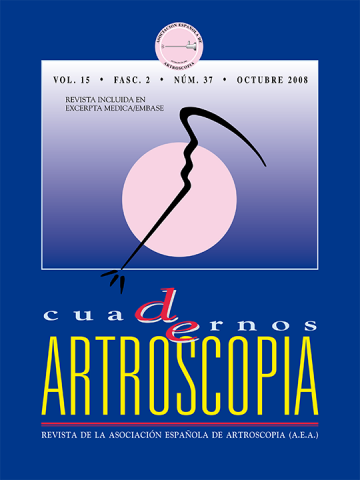Resumen:
Objetivo: evaluar si la técnica del doble fascículo (DF) mejora la laxitud de la rodilla en la reconstrucción del LCA frente a la técnica de fascículo único (FUH) pero en una posición del túnel femoral más horizontal (las 10 h o las 2 h del reloj).
Material y métodos: es un estudio prospectivo y aleatorizado. Hemos aleatorizado a 40 pacientes, 20 en el grupo DF y 20 en el FUH. Para el FUH, se han utilizado las cuatro bandas de semitendinoso –recto interno autólogo–; y para el DF, la técnica habitual de cuatro túneles con los mismos tendones. Para valorar resultados, se ha realizado el test completo de evaluación subjetiva de la rodilla del International Knee Documentation Committee (IKDC). En todos se han efectuado radiografías estándar y radiología forzada para la inestabilidad anteroposterior.
Resultados: todos los pacientes completaron el estudio. No hubo diferencias significativas en cuanto a la homogeneidad inicial en los dos grupos. En el seguimiento no se encontraron diferencias al comparar ambos grupos, aunque sí diferencias significativas (p < 0,05) entre el preoperatorio y posoperatorio de ambos grupos. El índice IKDC también presentó diferencias significativas a los 18 meses. En el grupo FUH, la puntuación media pasó de 58,2 ± 11,4 a 83,6 ± 10,8 (p = 0,011); y en el grupo DF, de 62,7 ± 16,5 a 84,4 ± 9,4 (p = 0,009). No se encontraron diferencias significativas en el apartado de examen de la rodilla.
Conclusiones: el descenso desde la 1 o las 11 del reloj a las 2 o las 10 no muestra resultados significativamente diferentes en ambas técnicas respecto al desplazamiento del pivote, estabilidad anteroposterior manual y radiológica y en las puntuaciones del IKDC. Sin embargo, se han registrado diferencias significativas en ambos grupos de manera individual entre el preoperatorio y el postoperatorio.
Nivel de evidencia: nivel I, estudio prospectivo aleatorizado.
Abstract:
Purpose: to evaluate if the double bundle technique (DB) improves the laxity in the knee in an ACL reconstruction versus the single bundle technique (SBH), but with the femoral tunnel in a more horizontal position (at 10 or 2 o’clock).
Methods: this study is a randomized and prospective investigation. 40 patients were randomized, 20 in the DB group and 20 in the SBH group. For the SBH group 4 stranded semitendinosus and Gracilis autologous grafts were used, and for the DB group the conventional 4 tunnel technique with the same tendons was used. IKDC was used to evaluate results. Standardized radiographs and forced radiology were evaluated for anteroposterior instability for all of the patients.
Results: all patients completed the study. No significant differences were found in the initial homogeneity of both groups. At follow-up no differences were found when comparing both groups, although significant differences were found (p < 0.05) between the preoperative and postoperative evaluations for both groups. The IKDC index (subjective knee evaluation) also showed significant differences at the 18 months follow-up. The average scores for the SBH group increased from 58.2 ± 11.4 to 83.6 ± 10.8 (p = 0.011) and for the DB group average scores increased from 62.7 ± 16.5 to 84.4 ± 9.4 (p = 0.009). No significant differences were found in the knee examination section.
Conclusions: a descent in the femoral tunnel placement from 1 or 11 o’clock to 2 or 10 o’clock does not show significantly different findings between SBH and DB on the pivot-shift test, the manual and radiological anterior posterior stability and on the IKDC scores. However, significant differences in both groups were found between the preoperative and postoperative evaluations.
Level of evidence: level I, therapeutic prospective randomized trial.
Keywords:
Anterior cruciate ligament
Femoral tunnel
Randomized
Double bundle. Single bundle




